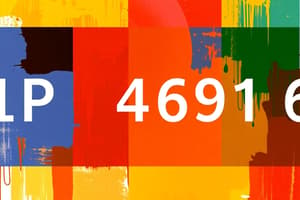Podcast
Questions and Answers
What is the purpose of a subnet mask in IP addressing?
What is the purpose of a subnet mask in IP addressing?
- To identify the number of routers in a network
- To encrypt data being transmitted in the network
- To separate the network and host portions of an IP address (correct)
- To assign specific addresses to each device on the network
If 2 bits are borrowed from the host portion for subnetting, how many subnets can be created?
If 2 bits are borrowed from the host portion for subnetting, how many subnets can be created?
- 6
- 8
- 2
- 4 (correct)
What happens to the number of usable host addresses when bits are borrowed for subnetting?
What happens to the number of usable host addresses when bits are borrowed for subnetting?
- It remains unchanged
- It doubles
- It triples
- It decreases (correct)
When partitioning the network with a starting address of 192.168.12.0 into four subnets, what is the resulting subnet mask?
When partitioning the network with a starting address of 192.168.12.0 into four subnets, what is the resulting subnet mask?
Which of the following best describes the relationship between the network bits and subnet bits after creating additional subnets?
Which of the following best describes the relationship between the network bits and subnet bits after creating additional subnets?
In order to achieve eight subnets, how many bits must be borrowed from the host portion of the IP address?
In order to achieve eight subnets, how many bits must be borrowed from the host portion of the IP address?
For a router-to-router link requiring only two host addresses, what would be the required subnet mask?
For a router-to-router link requiring only two host addresses, what would be the required subnet mask?
How does subnetting influence data packet routing within a network?
How does subnetting influence data packet routing within a network?
What is a potential drawback of using a subnet mask with many borrowed bits?
What is a potential drawback of using a subnet mask with many borrowed bits?
What calculation is performed to determine the number of usable hosts per subnet after subnetting?
What calculation is performed to determine the number of usable hosts per subnet after subnetting?
What subnet mask would allow only two host addresses on a router-to-router link?
What subnet mask would allow only two host addresses on a router-to-router link?
How does a subnet mask assist in determining data packet destinations?
How does a subnet mask assist in determining data packet destinations?
Given the IP address 172.16.35.3 and a subnet mask of 255.255.255.0, what is the destination network for internal communication?
Given the IP address 172.16.35.3 and a subnet mask of 255.255.255.0, what is the destination network for internal communication?
What would be the result of ANDing a destination IP address of 172.16.34.15 with a subnet mask of 255.255.255.0?
What would be the result of ANDing a destination IP address of 172.16.34.15 with a subnet mask of 255.255.255.0?
Which subnet mask allows for the maximum number of hosts while still being operationally effective?
Which subnet mask allows for the maximum number of hosts while still being operationally effective?
When using a subnet mask of 255.255.255.0, which range of IP addresses remains within the same network?
When using a subnet mask of 255.255.255.0, which range of IP addresses remains within the same network?
What key characteristic of a subnet mask facilitates the identification of the network address?
What key characteristic of a subnet mask facilitates the identification of the network address?
Which of the following statements is true regarding the subnet mask 255.255.255.192?
Which of the following statements is true regarding the subnet mask 255.255.255.192?
In the context of subnetting, what does 'borrowing bits' typically refer to?
In the context of subnetting, what does 'borrowing bits' typically refer to?
Flashcards
Subnetting
Subnetting
Dividing a network into smaller subnetworks using subnet masks.
Subnet Mask
Subnet Mask
A 32-bit number that defines the network and subnet portions of an IP address.
Borrowed bits
Borrowed bits
Bits from the host portion of the IP address used to create subnets.
Subnet
Subnet
Signup and view all the flashcards
Host portion
Host portion
Signup and view all the flashcards
Network portion
Network portion
Signup and view all the flashcards
Class C network
Class C network
Signup and view all the flashcards
Calculate Subnets
Calculate Subnets
Signup and view all the flashcards
Calculate Hosts/Subnet
Calculate Hosts/Subnet
Signup and view all the flashcards
Subnet Mask Example
Subnet Mask Example
Signup and view all the flashcards
Gateway IP address
Gateway IP address
Signup and view all the flashcards
IP address
IP address
Signup and view all the flashcards
255.255.255.252
255.255.255.252
Signup and view all the flashcards
255.255.255.0
255.255.255.0
Signup and view all the flashcards
ANDing
ANDing
Signup and view all the flashcards
Destination Network
Destination Network
Signup and view all the flashcards
Local Network
Local Network
Signup and view all the flashcards
Study Notes
Subnet Masks
- Subnetting is a technique used to divide networks into smaller networks called subnets.
- Subnet masks identify which bits in an IP address represent the network/subnet portion.
- Subnets are created by borrowing bits from the host portion of the IP address.
- Routers use this information to direct data packets to the correct subnet.
Subnetting - Class A, B, and C
- IPv4 addresses are divided into classes (A, B, and C).
- Each class has a different network and host bit structure.
- Class A networks have the most host bits, enabling a large number of hosts.
- Class C networks have the fewest host bits, allowing for smaller networks.
Borrowing Bits
- Subnets are created by borrowing bits from the host portion of the IP address.
- The number of subnets that can be created depends on the number of bits borrowed.
- The more bits borrowed, the smaller the subnet size and the fewer hosts per subnet.
Number of Subnets and Hosts
- The formula for calculating the number of subnets is 2x, where x is the number of bits borrowed.
- The formula for calculating the number of hosts per subnet is 2y-x - 2, where y is the number of host bits for a specific class network.
- The class number dictates how many bits are used for the host portion of the address.
Subnet Mask and Network/Subnet Bits
- A subnet mask is a 32-bit value that designates which bits in an IP address represent the network portion and which represent the host portion.
- A "1" bit in the subnet mask signals a network or subnet bit.
- A "0" bit signifies a host bit.
Logical AND operation
- Computers use a logical AND operation to determine if a destination IP address is on the same LAN.
- Setting a subnet mask bit to '1' allows data packet bits to pass.
- Applying a zero in the subnet mask effectively filters that bit from output.
Network and Broadcast Addresses
- Each subnet has a unique network address and a broadcast address.
- The network address identifies the subnet.
- The broadcast address is used to transmit data packets to all hosts within a subnet.
Example Subnet Calculation
- Given a Class C network (192.168.12.0), borrowing two bits can create four subnets (22).
- Each subnet would then have 64 hosts per subnet (28-2 -2)
Example 6-8
- Given a network address (10.0.0.0).
- Divide the network into 8 subnets.
- Specify the subnet mask (255.224.0.0) that creates the subnets.
- Calculate the broadcast addresses for each of the 8 subnets.
- Calculate the number of usable hosts per subnet.
Example 6-9
-
Determine the subnet mask required for a router-router link (172.16.31.1, 172.16.31.2).
-
Only two host addresses are required .
-
The subnet mask is (255.255.255.252)
-
Subnet Mask in Data Flow Control
-
The subnet mask helps guide data packets in a network to either a designated host on the LAN, or a gateway.
-
The gateway is usually a Layer 3 router or switch.
Summary
- The material presented covers the concept of subnetting, and its use in defining networks and subnet masks for controlling how data is transmitted across different networks.
- Detailed examples and calculations help students grasp the process of borrowing bits, determining the number of hosts per subnet, and identifying subnet masks for use in data traffic.
Studying That Suits You
Use AI to generate personalized quizzes and flashcards to suit your learning preferences.




